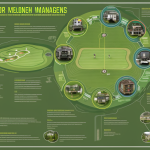Golf courses are often seen as a symbol of luxury and exclusivity, but they also come with a hefty environmental price tag. From the vast amounts of water they consume to the chemicals used to maintain their pristine greens, golf courses can have a significant impact on the environment. In this article, we will delve into the environmental issues surrounding golf courses and explore the question: why is a golf course unsustainable? We will examine the impact of golf courses on water resources, wildlife habitats, and climate change, and look at the efforts being made to make golf courses more sustainable. Whether you’re a golf enthusiast or simply interested in the environment, this article will provide an in-depth look at the environmental impact of golf courses and the challenges facing the industry as it strives to become more sustainable.
The Problem with Traditional Golf Course Design
Water Usage
Traditional golf course design has led to a significant problem of water usage. The construction and maintenance of golf courses require a large amount of water, which can have negative impacts on the environment. Here are some details about the issue:
Water Scarcity
Water scarcity is a growing concern in many regions where golf courses are located. The increasing demand for water resources, coupled with climate change, can lead to water scarcity, especially during the summer months. This can cause problems for the surrounding ecosystems and local communities.
Water Quality
Golf courses often use large amounts of water, which can lead to the pollution of nearby water sources. Pesticides, fertilizers, and other chemicals used on the golf course can leach into the soil and groundwater, causing harm to aquatic life and other ecosystems.
Irrigation Systems
Traditional irrigation systems used on golf courses can be inefficient and wasteful. Over-watering can lead to excessive runoff, which can cause erosion and damage to nearby streams and rivers. In addition, leaks and broken sprinklers can waste a significant amount of water.
Alternative Approaches
To address the issue of water usage on golf courses, alternative approaches are being developed. One approach is to use drought-resistant grasses and other plant species that require less water. Another approach is to use recycled water or rainwater for irrigation, which can reduce the demand for potable water. In addition, some golf courses are implementing more efficient irrigation systems, such as drip irrigation and weather-based scheduling, to reduce water waste.
Overall, the issue of water usage on golf courses is a significant environmental concern. However, by adopting sustainable practices and alternative approaches, golf courses can reduce their impact on the environment and promote more sustainable practices.
Chemical Pesticides and Fertilizers
Golf courses require a well-manicured appearance to maintain their aesthetic appeal, but the use of chemical pesticides and fertilizers has raised concerns about their environmental impact.
- Chemical pesticides are widely used to control weeds, insects, and other pests on golf courses. However, these chemicals can harm beneficial insects, birds, and other wildlife, as well as contaminate groundwater and soil.
- Fertilizers are also commonly used to maintain the lush green appearance of golf courses. However, excessive use of fertilizers can lead to nutrient runoff and pollution of nearby water bodies, causing harmful algal blooms and other environmental problems.
- Furthermore, the use of chemical pesticides and fertilizers can result in the development of pesticide-resistant pests, making it necessary to use more toxic chemicals to control them, thus creating a vicious cycle.
- In recent years, there has been a growing awareness of the negative environmental impact of traditional golf course management practices, leading to the development of more sustainable alternatives.
Energy Consumption
Traditional golf course design has often been criticized for its high energy consumption, which contributes significantly to the overall environmental impact of golf courses. In order to maintain the pristine conditions required for golf, these courses typically rely heavily on energy-intensive practices such as irrigation, heating and cooling, and the use of chemicals.
One of the most significant sources of energy consumption on golf courses is irrigation. Golf courses require a great deal of water to maintain their lush green appearance, and this water is often pumped from local sources or supplied through a network of underground pipes. In some cases, golf courses even have their own wells and treatment facilities to ensure a steady supply of water.
Irrigation systems are also often powered by electricity, which can add significantly to the energy consumption of a golf course. In addition, the energy required to pump and treat water can contribute to greenhouse gas emissions, which contribute to climate change.
Another significant source of energy consumption on golf courses is the use of heating and cooling systems. Many golf courses are located in areas with extreme temperatures, and the use of heating and cooling systems is necessary to maintain comfortable conditions for players and staff. These systems are often powered by fossil fuels, which contribute to greenhouse gas emissions and climate change.
Finally, the use of chemicals on golf courses can also contribute to energy consumption. Pesticides and fertilizers are often used to maintain the pristine conditions of golf courses, but these chemicals can be harmful to the environment and require significant energy to produce and apply.
Overall, the high energy consumption of traditional golf course design can have significant environmental impacts. As sustainability becomes an increasingly important concern for golf courses, many are turning to more eco-friendly practices to reduce their energy consumption and minimize their impact on the environment.
The Benefits of Sustainable Golf Course Design
Water Conservation
One of the key benefits of sustainable golf course design is water conservation. Golf courses are notorious for their high water usage, as maintaining lush greens and fairways requires a significant amount of irrigation. However, by implementing sustainable practices, golf courses can reduce their water consumption and minimize their impact on local water sources.
Some of the ways that sustainable golf course design promotes water conservation include:
- Using drought-resistant grasses: Many golf courses in arid regions have begun to switch to drought-resistant grasses, which require less water to maintain. These grasses are specifically bred to thrive in hot and dry conditions, reducing the need for irrigation.
- Implementing efficient irrigation systems: Sustainable golf courses use efficient irrigation systems that deliver water directly to the roots of the plants, reducing evaporation and runoff. These systems may include drip irrigation, rain sensors, and smart controllers that adjust watering schedules based on weather conditions.
- Capturing and reusing greywater: Some golf courses collect and treat greywater (wastewater from sinks, showers, and washing machines) for reuse on the course. This can significantly reduce the amount of fresh water needed for irrigation.
- Using natural rainfall: By implementing practices such as using organic fertilizers and incorporating native plants, golf courses can promote healthy soil that retains moisture, reducing the need for irrigation. Additionally, by maintaining biodiverse habitats, golf courses can help to prevent soil erosion and improve the overall water retention capacity of the landscape.
Overall, by incorporating water conservation practices into their design and maintenance, sustainable golf courses can help to protect local water sources and reduce their environmental impact.
Integrated Pest Management
Integrated Pest Management (IPM) is a sustainable approach to controlling pests on golf courses that minimizes the use of chemical pesticides and promotes environmental stewardship. IPM is based on the principle that pests should be managed through a combination of techniques, including biological control, cultural practices, and chemical control, in order to achieve long-term pest management while minimizing negative impacts on the environment.
One of the key benefits of IPM is that it allows golf course managers to identify and address pest problems before they become severe, thereby reducing the need for costly and environmentally damaging pesticide applications. This is achieved through regular monitoring of the golf course for signs of pest activity, such as insect damage or disease symptoms, and through the use of non-chemical control methods where possible.
Biological control is a key component of IPM, and involves the use of natural enemies, such as predators and parasites, to control pest populations. For example, in some cases, golf course managers may introduce beneficial insects, such as ladybugs or lacewings, to the golf course to help control pest populations. This approach can be particularly effective for controlling pests that are difficult to manage with chemical pesticides, such as certain types of insects or weeds.
Cultural practices, such as proper irrigation and fertilization, can also help to reduce pest problems on golf courses. For example, maintaining healthy turfgrass can help to reduce the likelihood of pest infestations by providing natural barriers and competing with pest species for resources.
Finally, chemical control methods can be used as a last resort in IPM, and should be carefully targeted to specific pest populations in order to minimize negative impacts on the environment. This may involve the use of low-toxicity pesticides, or the application of pesticides in a way that minimizes exposure to non-target species, such as through the use of spot treatments or targeted applications.
Overall, IPM provides a sustainable approach to pest management on golf courses that minimizes negative impacts on the environment while still allowing golf course managers to effectively control pest populations. By using a combination of techniques, including biological control, cultural practices, and chemical control, IPM allows golf courses to balance the need for pest management with the need for environmental stewardship.
Renewable Energy Sources
Incorporating renewable energy sources into golf course design is a crucial aspect of sustainability. Golf courses typically consume a significant amount of energy, primarily for irrigation, lighting, and heating/cooling. By implementing renewable energy sources, golf courses can significantly reduce their carbon footprint and promote a more sustainable future.
One common renewable energy source employed in golf course design is solar power. Solar panels can be installed on golf course buildings, such as clubhouses and maintenance facilities, to generate electricity. Additionally, solar-powered irrigation systems can be utilized to reduce the energy consumption associated with pumping water onto the course.
Another renewable energy source gaining popularity in golf course design is wind power. Wind turbines can be installed on the course or in close proximity to generate electricity. This is particularly effective in areas with strong wind currents, which are common near coastal regions and open plains.
Geothermal energy is another sustainable option for golf courses. This technology involves the use of underground heat to generate electricity or provide heating and cooling for buildings. Golf courses located near geothermal hotspots can benefit from this renewable energy source.
Biomass energy is another renewable energy source that can be utilized in golf course design. Organic waste, such as grass clippings and leaves, can be collected and used to generate electricity or heat water. This not only reduces waste but also provides an additional energy source for the golf course.
Overall, incorporating renewable energy sources into golf course design is a vital step towards sustainability. By reducing reliance on non-renewable energy sources, golf courses can minimize their environmental impact and contribute to a more sustainable future.
Green Space Preservation
Habitat Protection
Maintaining and preserving habitats is a crucial aspect of golf course sustainability. Golf courses often serve as ecological corridors, providing essential habitats for various plant and animal species. In addition, they can act as vital refuges for wildlife in urban or suburban areas. However, the development and maintenance of golf courses can also negatively impact habitats if not managed sustainably.
- Biodiversity Conservation:
- Creating and maintaining diverse ecosystems that support a wide range of plant and animal species is a key aspect of habitat protection on golf courses. This includes the use of native plant species, which provide essential food sources and habitat for local wildlife. By promoting biodiversity, golf courses can support healthy ecosystems and help maintain the balance of nature.
- Wildlife-Friendly Design:
- Golf course designers and managers can incorporate features that support wildlife habitat protection. This may include the creation of wetlands, the retention of natural vegetation, and the inclusion of wildlife corridors that connect habitats across the course. By designing courses that cater to wildlife, golf courses can help maintain ecological balance and promote the coexistence of golf and nature.
- Habitat Restoration:
- Golf courses may also participate in habitat restoration efforts, working to restore degraded or damaged habitats. This can involve the removal of invasive species, the reintroduction of native species, and the restoration of natural hydrological processes. By engaging in habitat restoration, golf courses can help to reverse the degradation of natural habitats and contribute to the overall health of local ecosystems.
- Integrated Pest Management:
- The use of pesticides and other chemicals can have detrimental effects on habitats and wildlife. Therefore, golf courses should implement integrated pest management (IPM) practices to minimize the use of harmful chemicals. IPM focuses on using a combination of cultural, biological, and chemical methods to manage pests, reducing the impact on the environment and preserving habitats for wildlife.
By adopting sustainable practices and prioritizing habitat protection, golf courses can play a crucial role in preserving and enhancing local ecosystems, promoting the coexistence of golf and nature.
Biodiversity
Golf courses are often criticized for their negative impact on local ecosystems, particularly in terms of habitat destruction and the use of chemical pesticides and fertilizers. However, it is important to recognize that golf courses can also serve as important habitats for a variety of plant and animal species. In fact, many golf courses are designed to incorporate natural features such as wetlands, streams, and native vegetation, which can provide valuable ecosystem services such as water filtration and erosion control.
One of the key benefits of golf courses for biodiversity is their ability to create and maintain large areas of green space in urban and suburban areas. These areas of green space are essential for supporting a wide range of plant and animal species, particularly those that are adapted to living in grassland or wetland habitats. In addition, golf courses can provide important corridors for wildlife to move through and connect with other natural areas.
However, it is important to note that not all golf courses are created equal when it comes to their impact on biodiversity. Some courses may be designed and managed in ways that minimize their environmental footprint and enhance ecosystem services, while others may be more harmful to local ecosystems. For example, courses that use excessive amounts of chemical pesticides and fertilizers can harm local wildlife and pollute waterways. Additionally, courses that destroy natural habitats or alter hydrological patterns can have significant negative impacts on local ecosystems.
Therefore, it is important for golf course managers and designers to take a proactive approach to biodiversity conservation. This can include measures such as reducing the use of chemical pesticides and fertilizers, incorporating natural features into course design, and creating habitats for local wildlife. By taking these steps, golf courses can become more sustainable and contribute to the preservation of local ecosystems.
Carbon Sequestration
Golf courses are often criticized for their environmental impact, particularly in terms of water usage and pesticide application. However, these areas of concern have led to a greater focus on sustainability and environmental stewardship within the golf industry. One key area of environmental benefit is carbon sequestration.
Carbon sequestration refers to the process of capturing and storing carbon dioxide from the atmosphere, reducing the amount of greenhouse gases that contribute to climate change. Golf courses, with their vast expanses of vegetation, provide an ideal environment for carbon sequestration.
One of the primary ways that golf courses contribute to carbon sequestration is through the maintenance of turfgrass. Turfgrass is a highly efficient photosynthesizer, absorbing carbon dioxide from the atmosphere and converting it into oxygen. This process, known as carbon fixation, is a key component of the golf course’s environmental impact.
In addition to carbon fixation, golf courses also provide habitat for a variety of plant and animal species, contributing to biodiversity. This, in turn, helps to support healthy ecosystems that can absorb and store even more carbon.
While the environmental benefits of golf courses are clear, it is important to note that not all courses are created equal. Some courses may have been developed with little regard for environmental impact, resulting in excessive water usage and other negative consequences. However, many courses are now working to improve their sustainability practices, implementing measures such as water-saving technologies and integrated pest management strategies.
Overall, while the environmental impact of golf courses is complex and multifaceted, there is no doubt that these areas can provide significant benefits in terms of carbon sequestration and other aspects of environmental stewardship. As the golf industry continues to evolve and mature, it is likely that sustainability will remain a key focus, with courses working to minimize their impact on the environment while continuing to provide a unique and enjoyable experience for players.
The Future of Golf Course Sustainability
Technology Advancements
Golf courses have traditionally been a source of environmental concern due to their high water usage, chemical applications, and land conversion. However, advancements in technology are helping to address these issues and create more sustainable golf courses. Here are some examples of how technology is being used to improve the sustainability of golf courses:
- Automated Irrigation Systems: Irrigation is a significant water user on golf courses, accounting for up to 60% of water usage. Automated irrigation systems use weather data and soil moisture sensors to determine when and how much to water, reducing water waste and ensuring that the golf course is adequately watered without overuse.
- Efficient Lighting: Golf courses that operate at night can save energy by using efficient lighting systems, such as LED lights. These lights are more energy-efficient than traditional lights and can reduce energy usage by up to 75%.
- Recycling and Waste Reduction: Many golf courses are now implementing recycling programs to reduce waste and improve sustainability. This includes recycling grass clippings, leaves, and other organic materials, as well as using recycled materials in construction and landscaping projects.
- Electric Golf Carts: Gas-powered golf carts are a significant source of emissions on golf courses. Electric golf carts, on the other hand, produce zero emissions and are becoming increasingly popular. Some courses are even using solar panels to charge the carts, further reducing their carbon footprint.
- Green Roofs and Living Walls: Green roofs and living walls can help to reduce heat island effects, reduce stormwater runoff, and improve air quality. These features can also provide habitat for wildlife and improve the aesthetic appeal of the golf course.
Overall, technology advancements are playing a significant role in improving the sustainability of golf courses. By using these technologies, golf courses can reduce their environmental impact and create a more sustainable future for the sport.
Government Regulations
As governments around the world become increasingly concerned about the environmental impact of golf courses, regulations aimed at promoting sustainability are being put in place. These regulations can take various forms, from restrictions on the use of certain chemicals to requirements for water conservation and habitat preservation.
Restrictions on Chemical Use
One of the most significant ways in which government regulations are affecting golf courses is by limiting the use of certain chemicals. Pesticides and fertilizers, for example, can have a negative impact on local ecosystems and water sources. As a result, many governments are implementing regulations that restrict the use of these chemicals or require golf courses to use alternative, more environmentally friendly products.
Water Conservation Requirements
Another area in which government regulations are having an impact is water conservation. Golf courses are notorious for their high water usage, and in areas where water is a scarce resource, regulations are being put in place to limit this usage. Some courses are even being required to install artificial turf or other water-saving technologies.
Habitat Preservation Requirements
Finally, many governments are implementing regulations aimed at preserving habitats on and around golf courses. This can include requirements for maintaining native vegetation, creating wildlife corridors, and avoiding the destruction of wetlands and other sensitive ecosystems. By preserving these habitats, golf courses can help to support local biodiversity and maintain the delicate balance of the local ecosystem.
Public Awareness and Demand
The Role of Social Media in Raising Awareness
- The increasing use of social media platforms as a tool for environmental activism
- The ability of social media to amplify the voices of individuals and organizations advocating for sustainable golf course management practices
- The potential for social media to influence public opinion and consumer behavior, leading to greater demand for sustainable golf courses
The Growing Importance of Eco-consciousness Among Golfers
- The rising trend of eco-consciousness among golfers, with many expressing a desire to play on courses that prioritize sustainability
- The potential for this trend to drive the demand for sustainable golf courses, as golfers seek out courses that align with their values
- The role of golf associations and tournaments in promoting sustainable practices, which may influence the behavior of golfers and encourage them to support environmentally responsible courses
The Influence of Government Regulations and Incentives
- The potential for government regulations and incentives to drive the adoption of sustainable practices on golf courses
- The role of government agencies in promoting sustainable golf course management through education, training, and financial incentives
- The potential for government regulations to set minimum standards for sustainable practices on golf courses, encouraging course owners and operators to prioritize environmental responsibility
The Importance of Collaboration Between Stakeholders
- The need for collaboration between golf course owners and operators, government agencies, and environmental organizations to promote sustainable golf course management
- The potential for partnerships and collaborations to drive innovation and the adoption of new sustainable practices on golf courses
- The role of research institutions and academic partnerships in developing and promoting sustainable practices for golf courses
Overall, the growing demand for sustainable golf courses is driven by a combination of factors, including public awareness, eco-consciousness among golfers, government regulations and incentives, and collaboration between stakeholders. As these factors continue to shape the golf industry, it is likely that the adoption of sustainable practices on golf courses will become increasingly widespread, contributing to a more environmentally responsible and sustainable future for the sport.
Economic Benefits of Sustainable Golf Courses
Reduced Operating Costs
Adopting sustainable practices on golf courses can lead to significant reductions in operating costs, benefiting both the golf course owners and the environment. Here are some ways in which sustainable golf courses can achieve reduced operating costs:
- Water Conservation: Implementing efficient irrigation systems and using recycled water can reduce water usage on golf courses, which is often a significant expense. By adopting sustainable water management practices, golf courses can save money on their water bills and also help conserve this precious resource.
- Energy Efficiency: Using energy-efficient lighting and appliances, and implementing renewable energy sources like solar panels, can significantly reduce energy consumption and costs. This not only helps the golf course save money but also reduces its carbon footprint and promotes a more sustainable energy system.
- Integrated Pest Management: Adopting sustainable pest management practices can reduce the need for chemical pesticides, which are both expensive and harmful to the environment. Integrated pest management strategies involve using natural predators, biological controls, and cultural practices to manage pests, resulting in reduced pesticide use and costs.
- Waste Reduction: Implementing waste reduction and recycling programs can help golf courses save money on waste disposal and also reduce their environmental impact. By recycling materials like turf clippings, leaves, and wood chips, golf courses can create a more sustainable waste management system and save money on waste removal.
- Sustainable Landscaping: Using native plants and creating habitats for local wildlife can enhance the golf course’s natural beauty and also reduce maintenance costs. Native plants require less water, fertilizer, and pesticides, making them a cost-effective and environmentally friendly choice for golf course landscaping.
By implementing these sustainable practices, golf courses can achieve reduced operating costs while also promoting environmental responsibility and sustainability. This win-win situation benefits both the golf course owners and the environment, making sustainable golf courses a viable and attractive option for the future.
Increased Property Values
- The proximity of a golf course to a property can significantly increase the property’s value.
- A study conducted by the National Association of Home Builders found that properties located within a mile of a golf course had a higher median sales price than those located further away.
- The increase in property value is attributed to the amenities and aesthetic appeal that a golf course provides, such as green spaces, water features, and views.
- This increased property value can benefit both homeowners and developers, as it can provide a greater return on investment for property sales or development projects.
- In addition, the presence of a golf course can also attract businesses and tourists to the area, further boosting the local economy.
- Overall, the economic benefits of sustainable golf courses can have a positive impact on the local community and the environment.
Enhanced Reputation and Branding
Adopting sustainable practices on golf courses can have a positive impact on the course’s reputation and branding. By demonstrating a commitment to environmental stewardship, golf courses can enhance their image and differentiate themselves from competitors. This can lead to increased patronage and higher revenue streams.
Benefits of Positive Reputation
A golf course with a positive reputation is more likely to attract new customers and retain existing ones. This is because golfers are increasingly seeking out courses that are environmentally responsible and socially conscious. By implementing sustainable practices, golf courses can create a favorable impression with environmentally-conscious golfers, leading to increased rounds played and greater revenue generation.
Differentiation from Competitors
Sustainable golf courses can differentiate themselves from competitors by showcasing their commitment to environmental stewardship. This can be a key selling point for golfers who are conscious of the environmental impact of their leisure activities. By highlighting their sustainable practices, golf courses can set themselves apart from competitors and attract environmentally-conscious golfers who are looking for courses that share their values.
Enhanced Branding Opportunities
Sustainable golf courses can also benefit from enhanced branding opportunities. By highlighting their sustainable practices, golf courses can generate positive media coverage and attract attention from environmental organizations and publications. This can lead to increased brand awareness and a more favorable reputation among golfers and non-golfers alike.
In conclusion, implementing sustainable practices on golf courses can have a positive impact on the course’s reputation and branding. By demonstrating a commitment to environmental stewardship, golf courses can differentiate themselves from competitors, attract environmentally-conscious golfers, and generate positive media coverage. This can lead to increased revenue streams and a more favorable reputation among golfers and non-golfers alike.
The Role of Golf Course Owners and Operators
Education and Training
Education and training play a crucial role in the sustainability of golf courses. Golf course owners and operators need to be knowledgeable about the best practices for maintaining the course while minimizing its environmental impact. They must also understand the importance of implementing these practices and communicate this to their staff and players.
Here are some of the key areas where education and training are essential:
Irrigation Management
Irrigation is a significant contributor to the water usage of golf courses. Proper irrigation management can help reduce water consumption and improve the overall sustainability of the course. Golf course owners and operators should receive training on how to use efficient irrigation systems and how to develop an appropriate watering schedule based on weather conditions and plant requirements.
Pesticide and Fertilizer Use
The use of pesticides and fertilizers can have a significant impact on the environment. Golf course owners and operators should receive training on how to use these chemicals responsibly and minimize their impact on the environment. This includes learning about alternative methods of pest control and the proper application of fertilizers to reduce runoff and leaching.
Turf Management
The type of turf used on a golf course can have a significant impact on the environment. Golf course owners and operators should receive training on how to select and maintain turf species that are well-suited to the local climate and soil conditions. This includes learning about the benefits of using native grasses and other low-maintenance turf alternatives.
Waste Management
Golf courses generate a significant amount of waste, including grass clippings, leaves, and branches. Golf course owners and operators should receive training on how to manage this waste in an environmentally responsible manner. This includes learning about composting techniques and how to use waste materials as a resource for the course, such as using grass clippings as a natural fertilizer.
Energy Conservation
Golf courses require a significant amount of energy to operate, including for irrigation, lighting, and heating and cooling. Golf course owners and operators should receive training on how to conserve energy and reduce their carbon footprint. This includes learning about energy-efficient equipment and how to use renewable energy sources, such as solar panels.
In conclusion, education and training are essential components of sustainable golf course management. By providing golf course owners and operators with the knowledge and skills they need to maintain their courses in an environmentally responsible manner, we can help reduce the environmental impact of golf courses and promote sustainability in the industry.
Investment in Sustainable Practices
As golf courses strive to minimize their environmental impact, many course owners and operators are investing in sustainable practices. This involves adopting environmentally friendly practices that reduce the course’s ecological footprint and promote sustainability. Here are some of the sustainable practices that golf courses are investing in:
- Energy-efficient equipment: Golf courses are investing in energy-efficient equipment, such as electric golf carts and solar-powered irrigation systems. These measures help reduce energy consumption and lower greenhouse gas emissions.
- Water conservation: With water scarcity being a growing concern, golf courses are investing in water-saving technologies, such as subsurface irrigation systems and recycled water usage. These measures help reduce water consumption and protect local water resources.
- Integrated pest management: Golf courses are adopting integrated pest management (IPM) practices, which involve using natural predators and other eco-friendly methods to control pests, rather than relying on chemical pesticides. This helps reduce the use of harmful chemicals and protect local ecosystems.
- Renewable energy: Some golf courses are investing in renewable energy sources, such as wind and solar power, to meet their energy needs. This helps reduce dependence on fossil fuels and lower greenhouse gas emissions.
- Waste reduction and recycling: Golf courses are implementing waste reduction and recycling programs to minimize their environmental impact. This includes composting organic waste, recycling used golf balls and tees, and reducing single-use plastics.
- Native plant restoration: Golf courses are restoring native plant species to their courses, which helps promote biodiversity and support local ecosystems. This also helps reduce the need for invasive species control and enhances the course’s aesthetic appeal.
By investing in these sustainable practices, golf courses can reduce their environmental impact and promote sustainability. These practices not only benefit the environment but also help golf courses save money and improve their reputation.
Collaboration with Local Communities and Environmental Organizations
Collaboration with local communities and environmental organizations is an essential aspect of sustainable golf course management. By working together, golf course owners and operators can address environmental concerns, protect local ecosystems, and promote sustainable practices. Here are some ways in which golf courses can collaborate with local communities and environmental organizations:
Participating in Environmental Assessments and Monitoring Programs
Golf courses can participate in environmental assessments and monitoring programs to evaluate the impact of their operations on local ecosystems. These programs often involve collecting data on water quality, soil health, wildlife populations, and other environmental factors. By sharing this data with local communities and environmental organizations, golf courses can identify areas for improvement and develop strategies to minimize their environmental footprint.
Implementing Habitat Restoration and Enhancement Projects
Golf courses can collaborate with local communities and environmental organizations to implement habitat restoration and enhancement projects. These projects may involve planting native vegetation, restoring wetlands, or creating wildlife corridors. By working together, golf courses can help to protect and restore local ecosystems, promote biodiversity, and enhance the overall environmental health of the area.
Engaging in Community Outreach and Education
Golf courses can engage in community outreach and education to promote sustainable practices and raise awareness about environmental issues. This may involve hosting educational events, providing tours of the golf course, or participating in local environmental fairs and festivals. By sharing their knowledge and expertise, golf courses can help to educate the public about the importance of sustainability and the role that golf courses can play in protecting the environment.
Supporting Research and Development Initiatives
Golf courses can support research and development initiatives related to sustainable golf course management. This may involve partnering with universities, research institutions, or environmental organizations to fund research projects or develop new technologies and practices. By investing in research and development, golf courses can help to advance the field of sustainable golf course management and contribute to the development of innovative solutions for environmental challenges.
In conclusion, collaboration with local communities and environmental organizations is a critical component of sustainable golf course management. By working together, golf courses can address environmental concerns, protect local ecosystems, and promote sustainable practices. Through partnerships, habitat restoration and enhancement projects, community outreach and education, and research and development initiatives, golf courses can play an active role in promoting sustainability and protecting the environment.
FAQs
1. What is the environmental impact of golf courses?
Golf courses can have a significant impact on the environment. They require large areas of land, which can lead to habitat destruction and the displacement of native species. They also require a lot of water, which can be a strain on local water resources. Additionally, golf courses often use chemical pesticides and fertilizers, which can pollute nearby water sources and harm wildlife.
2. Why are golf courses unsustainable?
Golf courses are unsustainable because they are not designed to be self-sustaining ecosystems. They are typically designed to be aesthetically pleasing and to provide a challenging game of golf, rather than to support local ecosystems. This means that they require a lot of resources, such as water and chemicals, to maintain and can have a negative impact on the environment.
3. Can golf courses be made more sustainable?
Yes, golf courses can be made more sustainable. This can include things like using more drought-tolerant grasses, implementing water-saving technologies, and using alternative methods of pest control. Some golf courses have also implemented programs to restore native habitats and promote biodiversity. By making these changes, golf courses can reduce their environmental impact and become more sustainable.
4. Are there any benefits to having a golf course?
There can be benefits to having a golf course, such as providing recreational opportunities and supporting local businesses. Golf courses can also serve as a source of community pride and can be used for events and gatherings. However, it is important to consider the environmental impact of golf courses and to take steps to make them more sustainable.
5. What can I do to help make golf courses more sustainable?
There are several things you can do to help make golf courses more sustainable. You can support golf courses that have implemented sustainable practices and encourage others to do the same. You can also choose to play golf at courses that are certified as sustainable or that have implemented sustainable practices. Additionally, you can speak up and advocate for sustainable practices in your community. By taking these actions, you can help make golf courses more sustainable and reduce their environmental impact.









